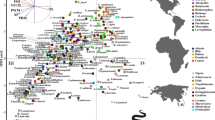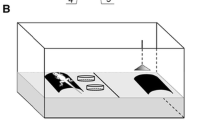Summary
Why are viviparous squamate reptiles more common in cold climates, and oviparous ones in warmer areas? The usual explanation is that (1) oviparous squamates cannot reproduce successfully in cold areas because soil temperatures are too low for embryonic development; and (2) viviparous squamates experience lower survivorship or reproductive success than oviparous taxa in warmer areas. These hypotheses suggest that the boundaries of geographic distributions of congeneric oviparous and viviparous squamates should be predictable from data on thermal tolerances of embryos, and estimated temperatures of soils and gravid female reptiles throughout the potential geographic range of the taxon. In large venomous Australian snakes of the genus Pseudechis, distributional boundaries of oviparous and viviparous taxa can be accurately predicted from such data. This predictive ability, if substantiated by studies of other reproductively biomodal squamate taxa, would support the putative role of reproductive mode as a direct determinant of reptilian geographic distributions.
Similar content being viewed by others
References
Cogger HG (1983) Reptiles and amphibians of Australia. Reed, Sydney, p 660
Cogger HG, Heatwole H (1981) The Australian reptiles: origins, biogeography, distribution patterns and island evolution. In: Keast A (ed) Ecological biogeography of Australia. Junk, The Hague, pp 1337–1373
Duellman WE (1965) A biogeographic account of the herpetofauna of Michoacan, Mexico. Univ Kansas Publ Mus Nat Hist 15:627–709
Dumas PC (1964) Species-pair allopatry in the genera Rana and Phrynosoma. Ecology 45:178–181
Fitch HS (1970) Reproductive cycles in lizards and snakes. Univ Kansas Mus Nat Hist Misc Publ 52:1–247
Fitch HS, Fitch AV (1967) Preliminary experiments on physical tolerances of the eggs of lizards and snakes. Ecology 48:160–165
Gibson E (1983) The gamma-taxonomy of Pseudechis guttatus and considerations of affinity with P. colletti (Squamata: Serpentes: Elapidae). Unpublished M Sc (Prelim) Thesis, Zoology, University of New England, Armidale
Greene HW (1970) Modes of reproduction in lizards and snakes of the Gomez Farias region, Tamaulipas, Mexico. Copeia 1970:565–568
Greer AE (1968) Mode of reproduction in the squamate faunas of three altitudinally correlated life zones in east Africa. Herpetologica 24:229–232
Heatwole H, Johnson CR (1979) Thermoregulation in the redbellied blacksnake, Pseudechis porphyriacus (Elapidae). Zool J Linn Soc (London) 65:83–101
Lillywhite HB (1980) Behavioral thermoregulation in Australian elapid snakes. Copeia 1980:452–458
Mell R (1929) Beiträge zur Fauna sinica. IV. Grundzüge einer Okologie der chinesischen Reptilien und einer herpetologischen Tiergeographie Chinas. Walter de Gruyter, Berlin, p 282
Mengden GA, Shine R, Moritz C (1986) Phytogenetic relationships within the Australasian venomous snakes of the genus Pseudechis. Herpetologica 42:211–225
Muth FA (1980) Physiological ecology of desert iguana (Dipsosaurus dorsalis) eggs: temperature and water relations. Ecology 61:1335–1343
Packard GC (1966) The influence of ambient temperature and aridity on modes of reproduction and excretion of amniote vertebrates. Am Natur 100:667–682
Parton WJ (1984) Predicting soil temperatures in a shortgrass steppe. Soil Science 138:93–101
Porter WC, Tracy CR (1983) Biophysical analyses of energetics, time-space utilization, and distributional limits. In: RB Huey, ER Pianka and TW Schoener (eds) Lizard Ecology. Studies of a Model Organism. Harvard University Press, Cambridge, Mass., pp 55–83
Sergeev AM (1940) Researches on the viviparity of reptiles. Moscow Soc Nat (Jubilee Issue): 1–34
Smith LA (1982) Variation in Pseudechis australis (Serpentes: Elapidae) in Western Australia and description of a new species of Pseudechis. Rec West Aust Mus 10:35–45
Shine R (1983a) Reptilian viviparity in cold climates: testing the assumptions of an evolutionary hypothesis. Oecologia (Berlin) 57:397–405
Shine R (1983b) Reptilian reproductive modes: the oviparity-viviparity continuum. Herpetologica 39:1–8
Shine R (1985) The evolution of viviparity in reptiles: an ecological analysis. In: Gans C, Billett F (eds) Biology of the Reptilia vol. 15. John Wiley and Sons, New York
Shine R (1987a) The evolution of viviparity: ecological correlates of reproductive mode within a genus of Australian snakes (Pseudechis, Elapidae). Copeia (in press)
Shine R (1987b) Intraspecific variation in thermoregulation, movements and habitat use by Australian blacksnakes, Pseudechis porphyriacus (Elapidae). J Herpetol (in press)
Shine R, Berry JF (1978) Climatic correlates of live-bearing in lizards and snakes. Am Natur 113:905–923
Tinkle DW, Gibbons JW (1977) The distribution and evolution of viviparity in reptiles. Misc Publ Mus Zool Univ Michigan 154:1–55
Weekes HC (1933) On the distribution, habitat and reproductive habits of certain European and Australian snakes and lizards, with particular regard to their adoption of viviparity. Proc Linn Soc New South Wales 58:270–274
White J (1981) Ophidian envenomation: a South Australian perspective. Rec Adelaide Children's Hospital 2:311–421
Author information
Authors and Affiliations
Rights and permissions
About this article
Cite this article
Shine, R. Reproductive mode may determine geographic distributions in Australian venomous snakes (Pseudechis, Elapidae). Oecologia 71, 608–612 (1987). https://doi.org/10.1007/BF00379306
Received:
Issue Date:
DOI: https://doi.org/10.1007/BF00379306




